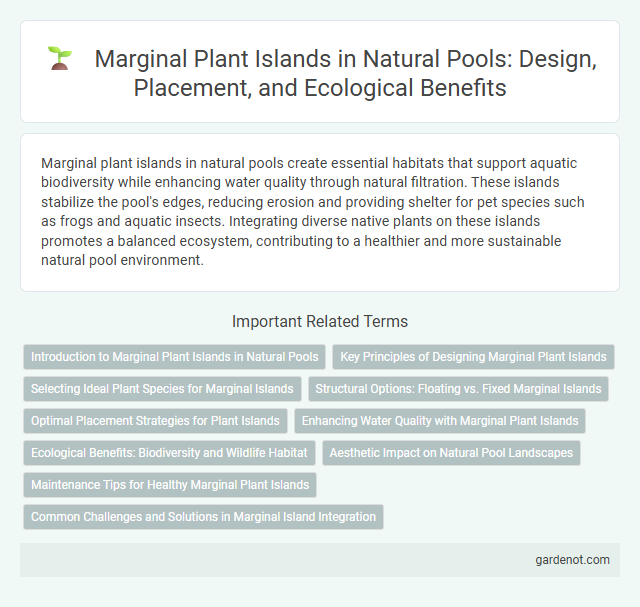Marginal plant islands in natural pools create essential habitats that support aquatic biodiversity while enhancing water quality through natural filtration. These islands stabilize the pool's edges, reducing erosion and providing shelter for pet species such as frogs and aquatic insects. Integrating diverse native plants on these islands promotes a balanced ecosystem, contributing to a healthier and more sustainable natural pool environment.
Introduction to Marginal Plant Islands in Natural Pools
Marginal plant islands are essential features in natural pools, serving as biological filters that enhance water quality by absorbing excess nutrients and providing habitat for beneficial microorganisms. These floating or rooted islands support a diverse range of aquatic plants, which contribute to stabilizing the pool's ecosystem and promoting biodiversity. Integrating marginal plant islands helps maintain clear, balanced water conditions while creating a visually appealing natural landscape.
Key Principles of Designing Marginal Plant Islands
Marginal plant islands in natural pools are designed to support biodiversity, water filtration, and aesthetic integration by selecting native aquatic plants that thrive in shallow water zones. Key principles include ensuring adequate root anchorage, promoting natural nutrient uptake to prevent algae growth, and creating habitat complexity to enhance aquatic life. Proper spacing and depth variation optimize sunlight exposure and oxygenation, contributing to the overall health of the ecosystem.
Selecting Ideal Plant Species for Marginal Islands
Selecting ideal plant species for marginal plant islands in natural pools involves prioritizing native aquatic plants that thrive in shallow water and promote ecological balance. Species such as water irises, pickerelweed, and cattails are well-suited for nutrient absorption and water filtration, enhancing water clarity and providing habitat for wildlife. Choosing plants with robust root systems ensures stability of the island structure while supporting biodiversity within the natural pool ecosystem.
Structural Options: Floating vs. Fixed Marginal Islands
Floating marginal plant islands offer flexibility and ease of installation, adapting to water level fluctuations while providing natural filtration and habitat for aquatic species. Fixed marginal islands require a solid foundation anchored to the pool bed, ensuring stability and durability, particularly in environments with strong currents or wave action. Choosing between floating and fixed options depends on the pool's design, maintenance preferences, and ecological goals for water purification and habitat support.
Optimal Placement Strategies for Plant Islands
Optimal placement of marginal plant islands in natural pools enhances water filtration by strategically positioning plants in areas with slow water flow and ample sunlight. Placing islands near the edges or shallow zones maximizes nutrient uptake, supports biodiversity, and stabilizes sediment. Proper island distribution encourages natural habitat formation while maintaining effective circulation and water quality.
Enhancing Water Quality with Marginal Plant Islands
Marginal plant islands serve as natural biofilters, effectively improving water quality in natural pools by absorbing excess nutrients and pollutants. These islands support a diverse range of aquatic plants whose root systems stabilize sediments and reduce turbidity. Their presence promotes balanced ecosystems by fostering beneficial microbial activity and oxygenation, crucial for maintaining clear, healthy water.
Ecological Benefits: Biodiversity and Wildlife Habitat
Marginal plant islands enhance natural pool ecosystems by providing essential habitats for diverse wildlife, including amphibians, insects, and birds. These islands promote biodiversity by supporting native aquatic and semi-aquatic plants that improve water quality through nutrient absorption and oxygen release. Their presence creates microhabitats that stabilize the pool's edge, fostering ecological balance and natural filtration processes.
Aesthetic Impact on Natural Pool Landscapes
Marginal plant islands enhance natural pool landscapes by introducing diverse textures and vibrant colors along the water's edge, creating a seamless transition between aquatic and terrestrial environments. These islands support native flora such as carex, juncus, and irises, which not only improve water quality through filtration but also offer habitats for beneficial wildlife, increasing biodiversity. Their strategic placement boosts the visual appeal of natural pools, fostering a tranquil and immersive naturalistic atmosphere.
Maintenance Tips for Healthy Marginal Plant Islands
Regular pruning and removal of dead or decaying foliage prevent disease and promote vigorous growth in marginal plant islands. Maintaining proper water levels and ensuring adequate sunlight exposure encourages healthy root development and nutrient uptake. Periodic inspection for pests and balancing soil nutrients enhances the overall resilience and aesthetic appeal of the natural pool's marginal plant zone.
Common Challenges and Solutions in Marginal Island Integration
Marginal plant islands often face challenges such as plant die-off due to water level fluctuations and nutrient imbalances affecting growth stability in natural pools. Solutions include selecting native, water-tolerant plant species with strong root systems that adapt to varying conditions and implementing controlled water management to maintain optimal nutrient levels. Incorporating modular floating islands with diverse vegetation can enhance resilience and improve water quality through natural biofiltration processes.
Marginal plant island Infographic

 gardenot.com
gardenot.com